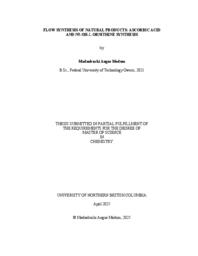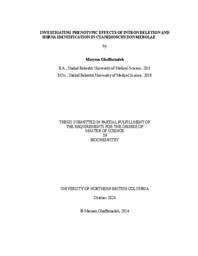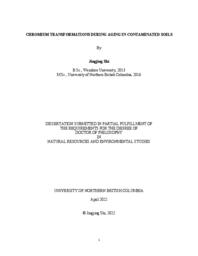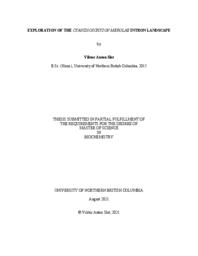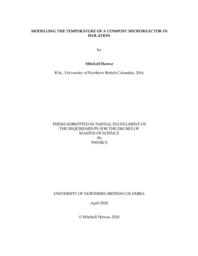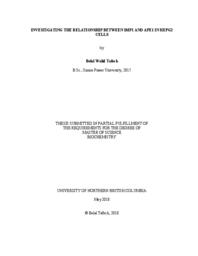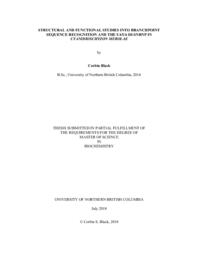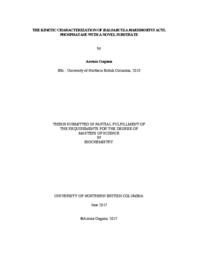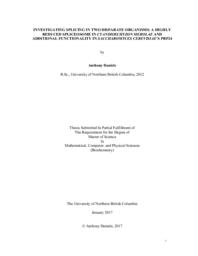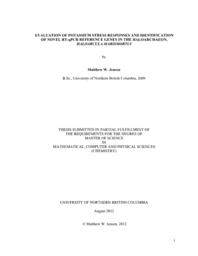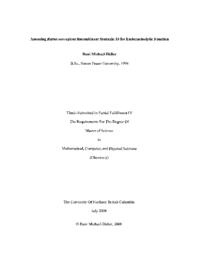Gorrell, Andrea
Person Preferred Name
Andrea Gorrell
Related Works
Content type
Digital Document
Origin Information
Content type
Digital Document
Origin Information
Content type
Digital Document
Origin Information
Content type
Digital Document
Origin Information
Content type
Digital Document
Description / Synopsis
Archaea, a domain of organisms possibly linked to the ancestry of eukarya and bacteria, displays a dichotomic evolutionary pattern. Haloarcula marismortui (H. marismortui), an archaeon discovered in the Dead Sea, has unique traits enabling survival and thriving in hypersaline environments. Research in this study includes investigating the Trk potassium transport system, which may contribute to stability of this archaeon in varying extreme environmental conditions. A primary focus on the TrkE protein role in the system, also known as SapD , which in Haloarcula marismortui is OppD1. The Trk system has been studied in several species, and through each it has been consistently found to be homologous to the E. coli sapABCDF operon, which has been found to encode an ABC transporter. Within this operon in E. coli TrkE is coded for by the SapD gene. The goal of this study was to clone the TrkE homolog from Haloarcula marismortui and continue with further research into the characterization of the protein to aid in the prediction of its overall function in potassium transport. Data in this study strongly suggest the size of the H. marismortui homolog of TrkE, OppD1, is larger than its E.coli homolog by approximately 10,000 Daltons. Further analysis also identified that the mainly alpha-helical protein has a significant sequence identity with SapD. Future considerations include looking at the purpose of the N-terminal extended region of OppD1 not seen in SapD, and further analyzing OppD1 for structure changes in varying salt conditions and possible binding partners. The exceptional survival skills of H. marismortui in high-salinity environments, possibly facilitated by the Trk system, make it an excellent model for studying halophiles. These insights offer valuable understanding into how halophiles maintain cellular integrity under harsh conditions, especially regarding OppD1's potential role within the Trk system for ion transport and osmotic regulation in different environmental settings.
Origin Information
Content type
Digital Document
Description / Synopsis
Extensive industrial activities have led to Cr contamination in the environment, which poses threats to ecosystems and human health. Currently, very little is known regarding the Cr accumulation in soils during aging. The purpose of this dissertation was (i) to enhance our understanding of Cr transformations occurring over a long period of time; (ii) to investigate the reduction of toxic Cr(VI) to non-toxic Cr(III) by soil microorganisms for developing bioremediation strategies for Cr-contaminated sites. Soil samples were collected from a longterm (> 30 years) tannery waste contaminated area in Shuitou (China) for this research. Chemical extraction methods showed the Cr(III) form was dominant (> 96.7% of total Cr) in these aged Cr-contaminated soils, with toxic Cr(VI) up to 144 mg kg-1. Of the total Cr(VI) present, immobile Cr(VI) represented > 90%. Synchrotron-based X-ray near edge structure spectroscopy demonstrated Cr species present were CrFeO3, CrOOH, and CaCrO4. The occurrence of immobile Cr(VI) species in long-term contaminated soils was further verified by a spiking experiment over 240-day aerobic incubation. Available Cr(VI) in soils continually decreased during aging, with immobile Cr(VI) increasing by 4.5 – 31% and immobile Cr(III) increasing by 68 – 95% of total spiked Cr(VI). These findings reveal that Cr(VI) reduction and immobilization were occurring concurrently in soils. Cr(VI) reduction occurs in soils with low pH and high organic carbon content via both chemical and biological processes, while Cr(VI) immobilization occurs in soils with cations (such as Ca2+) and Fe oxides. Shotgun metagenomic sequencing was used to analyze the microbial community composition in the soils and a batch solution experiment was employed to determine the Cr(VI) reduction capacity by soil microbial consortia. The results demonstrated the accumulation of high levels of Cr in a soil (e.g., 3141 mg kg-1 in S3-2) led to the increased abundance of Cr resistant and reducing microorganisms: Proteobacteria (69.9%) at phylum level, Betaproteobacteria (39.1%) at class level, and Massilia (12.6%) and Bacilli (0.57%) at genus level. Batch experiment results showed the addition of 1.0 g Cr-contaminated soils reduced 10 – 20 mg L-1 Cr(VI) in 20 mL of K2Cr2O7 solution at the condition of 30 oC at pH 7.8 – 8.0 within 7 days anaerobically and aerobically, when supplied with 0.2 g L-1 of Na-acetate as carbon and electron sources. The amount of Cr(VI) removed was highest (29.0 mg L-1) at 40 mg Cr(VI) L-1 in the presence of soil S3-2. Therefore, prospective application of mixed microbial consortia from high Cr-contaminated soils for bioremediation of Cr(VI)-polluted environments could be expected.
Origin Information
Content type
Digital Document
Description / Synopsis
The eukaryotic process of pre-mRNA splicing involves the removal of noncoding intron sequences and the fusion of the remaining protein-coding exon sequences. The splicing reaction is catalyzed by the spliceosome, a dynamic multi-megadalton ribonucleoprotein complex that, in humans, is composed of 5 small nuclear RNAs (snRNAs) and over 200 associated proteins acting on more that 200,000 introns present within 25,000 genes. The unicellular red alga Cyanidioschyzon merolae possesses a more tractable splicing environment, with only 4 snRNAs and 75 associated proteins interacting with 27 annotated introns found in 26 our of 5,331 genes. Intron-rich genomes can confer benefits to their host species such as improved gene expression, incredible proteomic diversity, and increased genetic stability. This raises the question of why intron-poor C. merolae has retained such a small number of introns and a dramatically reduced spliceosome. A comprehensive investigation into the precise role that introns play in C. merolae would require the systematic removal of introns and an analysis of the effects thereof. The ability to elucidate the role of splicing in C. merolae via genome-wide intron deletion, however, hinges on the feasibility of establishing the efficiently scalable CRISPR genome engineering tool in C. merolae. It also follows that such an endeavour would require an accurate picture of the intron landscape of C. merolae, and since the number of annotated introns in C. merolae is relatively small, it is especially vital to determine whether any introns are missing from the C. merolae annotation. To that end, a stable and inducible Cas9-expressing strain of C. merolae was successfully developed. Transcriptome analysis using RNA-seq data revealed the discovery of 11 novel introns and 1 misannotated intron, as well as the presence of alternative splicing in the form of alternative splice site usage.
Origin Information
Content type
Digital Document
Description / Synopsis
A mixture of waste-wood biomass and municipal biosolids waste was composted in a plastic container inside of an insulated chamber. The mixture of biomass and biosolids was approximately 50:50 and weighed 82.6 kg. The peak temperature of the compost was 32.4◦C. The small scale of the compost system allowed the lower limit of the compost decomposition rate to be studied. A model was successfully developed to predict the core temperature of the compost using the ambient temperature in the insulated chamber. A literature review was conducted to determine literature values for the overall convective and conductive heat transfer coefficient, the dry mass fraction, and heat of combustion for both biomass and biosolids. The model used an optimization algorithm to calculate the rate constant for the experimental setup. The calculated decomposition rate constant was 0.0525 Day−1.
Origin Information
Content type
Digital Document
Origin Information
Content type
Digital Document
Origin Information
Content type
Digital Document
Origin Information
Content type
Digital Document
Origin Information
Content type
Digital Document
Origin Information
Content type
Digital Document
Origin Information

